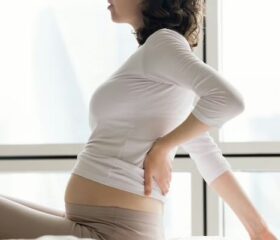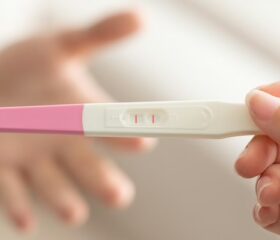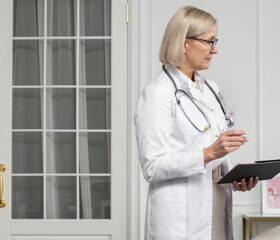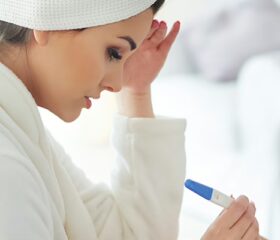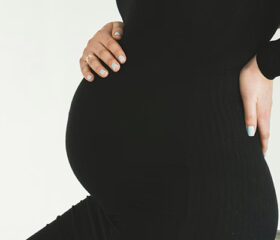Does Ovulation Pain Affect Pregnancy Success?
Many women deal with pain and cramping around the middle of their cycles, which is often when ovulation occurs. Does experiencing this ovulation pain indicate how likely you are to get pregnant?
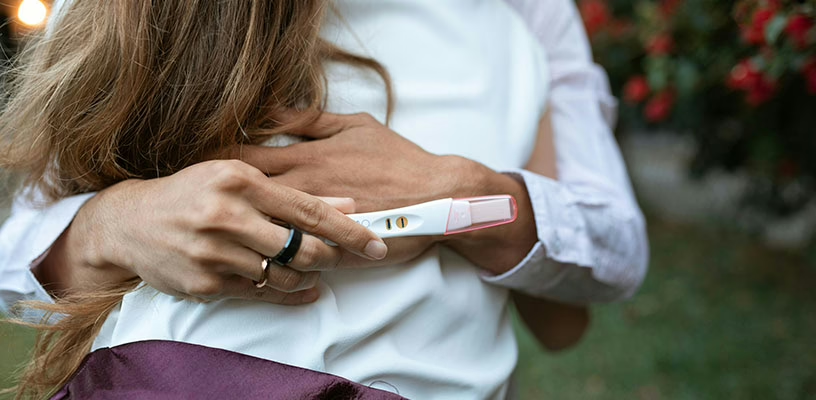
Ovulation pain, or mittelschmerz (German for “middle pain”), is a normal, albeit uncomfortable, part of many women’s menstrual cycles.
What does ovulation pain feel like, and is it a reliable indicator of your fertility? Read on to find out.
What is ovulation pain?
Ovulation pain is one-sided lower abdominal or pelvic pain that some women experience when one of their ovaries releases an egg, about two weeks before their period.
Not everyone experiences this, but it’s estimated that as many as 20%–40% of women may feel it at some point during their reproductive years. 1 2
While many women track ovulation pain if they’re trying to conceive, it’s not always a reliable sign of ovulation (something that it shares with the vast majority of ovulation symptoms).
What does ovulation pain feel like?
Mittelschmerz varies in intensity, but it’s often described as: 3
- A dull, achy cramp
- Mild twinging
- A sharp, sudden pain
Depending on which ovary releases an egg, you’ll feel pain on either the left or right side of your lower abdomen. Some women experience it every month, while others only feel it occasionally. You might notice that the pain alternates sides from month to month. 1
In addition to the pain, many women may also experience light vaginal spotting or discharge, along with ovulation-induced bloating. 4
What causes ovulation pain?
Experts still aren’t fully sure about the exact cause of ovulation pain, but there are a couple of leading theories: 1
- Follicle stretching: Before an egg is released, it develops within a follicle on the ovary. As the ovarian follicle grows, it may stretch the surface of the ovary, which can hurt.
- Follicle rupture: When the follicle ruptures to release the egg, it also releases fluid (and sometimes a small amount of blood). This may irritate the lining of the abdomen and pelvis.
- Prostaglandins: The same chemical that causes menstrual cramps might be behind ovulation pain as well. 5
How long does ovulation pain last?
Ovulation pain can last anywhere from a few minutes to a couple of days, though it most often subsides within a few hours.
That being said, you may also experience ovulation pain that lasts until your period starts (which will be around 14 days after ovulation if you have a regular 28-day cycle) if you previously had ovarian surgery. 2
What if you’re still getting cramps after ovulation?
Remember that ovulation is a short event in your cycle. When an egg is released from one of your ovaries, it’ll only be viable for 24 hours.
If you’re still getting cramps 2, 3, or more days after ovulating (and didn’t have ovarian surgery in the past), it’s likely that something else is causing your pain. In this case, speak to your doctor, especially if your pain is paired with vaginal spotting or unusual discharge. 1
Ovulation can cause other types of pain
While the primary symptom of ovulation pain is lower abdominal or pelvic discomfort, hormonal shifts during this time can also trigger pain in the lower back and tenderness or sensitivity of the breasts and nipples. You may also get breast tenderness on one side. 6
Does ovulation pain mean you’re more likely to get pregnant?
No, there’s no link between having ovulation pain and your chances of conceiving (or having a successful pregnancy if you do conceive).
Ovulation pain can sometimes indicate that you’re entering your fertile window, but it can’t tell you how viable your eggs actually are or whether one of them will successfully be fertilized.
Moreover, many women don’t experience ovulation pain every month (or at all) and are still able to successfully conceive. Not having ovulation pain doesn’t influence your chances of pregnancy success and isn’t a sign of infertility or any other issues.
Using ovulation predictor kits to identify your fertile window
Since it can be tricky to determine your chances of getting pregnant from ovulation symptoms alone, you’re best off using other methods to find out when you’re ovulating.
For instance, many women use ovulation predictor kits (OPKs) to track ovulation over various cycles.
These kits detect the surge in luteinizing hormone (LH) that triggers ovulation. 7 If you get a positive ovulation test result (i.e., the testing line is darker than the control line), it indicates that you’re entering your LH surge and will probably ovulate within 36 hours. 8
Once your ovulation is over, your LH levels drop quickly, and you’ll no longer be in your fertile period.
You’ll usually have a good chance of getting pregnant after seeing a positive ovulation test result if you have sex within those 36 hours.
That being said, these tests can sometimes give you misleading results, such as if:
- You have a medical condition: Conditions like polycystic ovary syndrome (PCOS) can sometimes cause you to have elevated LH levels throughout your cycle. 9 In this case, it’ll be difficult to track your ovulation while suffering from PCOS. You’re best off speaking to your doctor if you’re trying to get pregnant with PCOS.
- You’re taking fertility medications: Fertility medications like Clomid can also elevate your LH levels and give you a false positive result on your test. 10 11
- You’re pregnant: During the early days of pregnancy, your body produces the hormone human chorionic gonadotropin (hCG). Since LH and hCG have similar molecular structures, you might see a dark or faint positive test result on your ovulation test if you’re pregnant already. 12
Other ways to track ovulation
If you’re trying to get pregnant, you can track your ovulation with: 13
- Your basal body temperature (BBT): This is your resting body temperature. Many women claim their BBT rises slightly during and after ovulation. However, the evidence for this is limited, and many women may not experience any significant changes to their BBT before ovulating.
- Your cervical mucus: You may notice that your vaginal discharge changes around the time you ovulate. Many women say this ovulation discharge is clearer and more slippery, often resembling raw egg whites.
- Ovulation calculators: These tools estimate your monthly fertile period based on the date of your last period. Keep in mind that these calculators generally work under the assumption that you have a regular 28-day menstrual cycle. If you want to track ovulation with irregular periods, a calculator might not be the best option.
What's the difference between ovulation pain and implantation cramps?
It’s also possible that what you perceive as “ovulation pain” is actually the result of implantation, which occurs when a fertilized egg implants in your uterine lining.
This event can sometimes cause “implantation cramps,” which you could easily mistake for ovulation pain.
The key difference between ovulation pain and implantation cramps lies in the timing. Ovulation pain occurs when you ovulate, as the name suggests. This usually occurs around 14 days before your next period (if you have a regular 28-day cycle). 4
On the other hand, if you conceive, you may get implantation cramps about a week after ovulation, around day 20 to 22 of a regular cycle. These cramps are also often accompanied by light spotting (implantation bleeding). 14
How to find relief from ovulation pain
If your ovulation pain is mild and doesn’t interfere with your daily activities, you may not need any treatment.
However, if the pain is bad, you can try:
- Applying a heating pad or taking a warm bath, which relaxes your muscles and may ease cramping
- Getting enough rest to help your muscles relax
- Taking over-the-counter pain relievers like acetaminophen (Tylenol) or NSAIDs like ibuprofen (Advil, Motrin)
You should speak with your doctor before taking ibuprofen if you’re actively trying to conceive. Some small studies suggest that it may increase the chance that an egg will fail to release during ovulation. 15
Using hormonal birth control to prevent ovulation cramping
Birth control pills that contain both progestin and estrogen prevent ovulation from happening. 16 17 Hormonal IUDs also sometimes prevent ovulation, but not consistently (meaning you may ovulate less frequently if you have an IUD, but ovulation won’t stop entirely).
Of course, if you’re trying to conceive, using birth control will prevent you from getting pregnant. You must be ovulating to successfully conceive.
When to see a doctor about your ovulation pain
While ovulation pain is usually harmless, watch out for symptoms that could indicate a more serious underlying medical issue.
Speak to your doctor if you have: 18 19 20 21 22
- Severe or persistent pain
- Nausea or vomiting
- Dizziness or lightheadedness
- A fever
- Foul-smelling or unusual vaginal discharge
- Painful urination
- Bleeding (more than spotting) between periods
These symptoms can be indicative of medical conditions, such as appendicitis, ovarian cysts, endometriosis, pelvic inflammatory disease (PID), or even a sexually transmitted infection (STI).
Ovulation pain and signs of ectopic pregnancy
If you suspect you might be pregnant, severe abdominal pain warrants immediate medical attention to rule out an ectopic pregnancy. This occurs when an egg fails to attach to the uterine wall, but instead attaches to the inside of the fallopian tube or elsewhere in the body. 23
Final thoughts
Ovulation pain is a common and generally harmless experience. But while it can sometimes signal when you’re about to enter your fertile window, having it doesn’t mean you’re more likely to get pregnant.
For the best chances of getting pregnant, use various ovulation-tracking methods simultaneously, and stay in close contact with your doctor.
Article Sources
- MedlinePlus. "Mittelschmerz" Retrieved September 11, 2025.
- StatPearls. "Mittelschmerz" Retrieved September 11, 2025.
- Harvard Health Publishing. "Mid-menstrual cycle pain (mittelschmerz)" Retrieved September 11, 2025.
- University of Utah Health. "Ovulation: When Is the Best Time to Get Pregnant?" Retrieved September 11, 2025.
- MedlinePlus. "Period Pain" Retrieved September 11, 2025.
- University of Rochester Medical Center. "Breast Pain (Mastalgia)" Retrieved September 11, 2025.
- American Pregnancy Association. "How to Use Ovulation Kits & Fertility Monitors" Retrieved September 11, 2025.
- Cleveland Clinic. "Ovulation" Retrieved September 11, 2025.
- Frontiers in Medicine. "Role of luteinizing hormone elevation in outcomes of ovulation induction with letrozole for polycystic ovary syndrome" Retrieved September 11, 2025.
- Mount Sinai. "Ovulation home test" Retrieved September 11, 2025.
- JAMA. "Diagnosis and Management of Infertility" Retrieved September 11, 2025.
- Women In Balance. "Will an Ovulation Test Be Positive If Pregnant?" Retrieved September 11, 2025.
- American College of Obstetricians and Gynecologists. "Fertility Awareness-Based Methods of Family Planning" Retrieved September 11, 2025.
- RMC Health System. "Implantation Cramping vs. Period Cramps" Retrieved September 11, 2025.
- MotherToBaby. "Ibuprofen" Retrieved September 11, 2025.
- University of Utah Health. "Birth Control Methods That Rely on Hormones" Retrieved September 11, 2025.
- Planned Parenthood. "What are hormonal IUDs?" Retrieved September 11, 2025.
- MedlinePlus. "Appendicitis" Retrieved September 11, 2025.
- MedlinePlus. "Ovarian Cysts" Retrieved September 11, 2025.
- MedlinePlus. "Endometriosis" Retrieved September 11, 2025.
- MedlinePlus. "Pelvic Inflammatory Disease" Retrieved September 11, 2025.
- MedlinePlus. "Sexually Transmitted Infections" Retrieved September 11, 2025.
- MedlinePlus. "Ectopic Pregnancy" Retrieved September 11, 2025.

